Select one or more regions of interest
by clicking on the filter elements
Drag the filter elements horizontally,
and select one or multiple
thematic areas of interest.

Family Farm in Transition: Climate-Smart Practices on a Dairy Farm in Geraardsbergen (Belgium)

Belgium
Temperate Maritime Climate
Benefits of the practice
1. Adoption of climate-smart practices through peer learning
2. Improved soil health, biodiversity, and feed quality
3. Increased resilience and sustainability of mixed farming systems
Production system(s)
Thematic Area(s)
Two years ago, Veerle and Colin took over Veerle’s parents’ dairy farm, transforming it from a classic dairy farm focused on producing mats for Geraardsbergen mattentaarten to a more sustainable operation. They now have 12 English Longhorns for meat and 70 dairy cows, along with 35 ha of arable land and 30 ha of grassland.
Veerle, with her background as an environmental lawyer, welcomed the climate scan proposal. The initial results from the Klimrek tool highlighted useful measures, some of which were implemented immediately, while others are planned.
Their climate measures include:
⦁ Hedges and Trees: Supported by Bos+ and Regional Landscape Flemish Ardennes, they focus on hedges, trees, and flower borders for carbon storage and biodiversity.
⦁ Grass Clover-Lucerne: They reduced fodder maize from 22 ha to 10 ha, replacing it with a grass clover-lucerne mix, requiring less fertilization.
⦁ Triticale – Field Beans: They planted 6 ha of triticale-field beans to replace soy in feed, with guidance from colleagues and project advisors.
⦁ Soil Health and Water Management: Switching to grass clover-lucerne and méteil has improved soil structure and water management, though it remains challenging.
⦁ Farm Composting: They see potential in using wood chips and manure for composting, hoping for regulatory approval soon.
⦁ Solar Panels and Heat Recovery: These are considered for future implementation.
Their farm is part of the Climate Farm Demo network, which connects pilot farms to demonstrate climate-smart practices and share knowledge. Local farmers provide invaluable support, especially Walloon colleagues who are more advanced in organic farming and agro-ecology.
Veerle and Colin believe in farming with nature while maintaining economic viability, emphasizing the need for greater appreciation and visibility of farmers’ efforts.
Twee jaar geleden namen Veerle en Colin het melkveebedrijf van Veerle’s ouders over, en transformeerden het van een klassiek melkveebedrijf, gericht op de productie van matten voor Geraardsbergse mattentaarten, naar een duurzamer bedrijf. Ze hebben nu 12 English Longhorns voor vlees en 70 melkkoeien, samen met 35 ha akkerland en 30 ha grasland.
Veerle, met haar achtergrond als milieujuriste, verwelkomde het voorstel voor een klimaatscan. De eerste resultaten van de Klimrek-tool benadrukten nuttige maatregelen, waarvan sommige onmiddellijk werden geïmplementeerd, terwijl andere voor de toekomst zijn gepland.
Hun klimaatmaatregelen omvatten:
⦁ Hagen en Bomen: Met steun van Bos+ en Regionaal Landschap Vlaamse Ardennen richten ze zich op hagen, bomen en bloemenranden voor koolstofopslag en biodiversiteit.
⦁ Grasklaver-Luzerne: Ze verminderden voedermaïs van 22 ha naar 10 ha, en vervingen het door een grasklaver-luzerne mengsel, dat minder bemesting vereist.
⦁ Triticale – Veldbonen: Ze plantten 6 ha triticale-veldbonen om soja in het voer te vervangen, met begeleiding van collega’s en projectadviseurs.
⦁ Bodemgezondheid en Waterhuishouding: De overstap naar grasklaver-luzerne en méteil heeft de bodemstructuur en waterhuishouding verbeterd, hoewel het uitdagend blijft.
⦁ Boerderijcompostering: Ze zien mogelijkheden in het gebruik van houtige snippers en mest voor compostering, en hopen op snelle goedkeuring van regelgeving.
⦁ Zonnepanelen en Warmteterugwinning: Deze worden overwogen voor toekomstige implementatie.
Hun bedrijf maakt deel uit van het Climate Farm Demo-netwerk, dat proefboerderijen verbindt om klimaatslimme praktijken te demonstreren en kennis te delen. Lokale boeren bieden onschatbare steun, vooral Waalse collega’s die verder zijn in biologische landbouw en agro-ecologie.
Veerle en Colin geloven in boeren met de natuur, terwijl ze de economische levensvatbaarheid behouden, en benadrukken de noodzaak van meer waardering en zichtbaarheid voor de inspanningen van boeren.
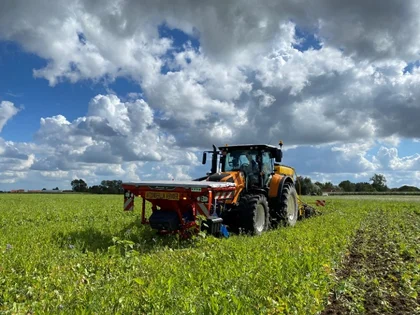
Soil Health as Capital: How Ongoing Experimentation Builds Sustainable and Productive Farming

Belgium
Temperate Maritime Climate
Benefits of the practice
1. Improved soil health
2. Reduced chemical inputs
3. Visible improvements in crop resilience
Production system(s)
Thematic Area(s)
By continuously experimenting and adapting, Stijn De Wulf, one of the Belgium Pilot Demo Farmers was able to manage sustainable farming with improved soil health and productivity.
Main Findings:
⦁ Transition to Sustainable Practices: Stijn De Wulf shifted from traditional plowing to non-inversion tillage, complex cover crops, and smart crop combinations. This transition was challenging but has shown positive effects in the field.
⦁ Reduction in Chemical Inputs: Stijn has significantly reduced the use of synthetic fertilizers and pesticides. He now grows his own animal feed autonomously and uses organic manure as a valuable resource.
⦁ Improved Soil Health: The changes in soil management have led to better soil structure and fertility, with visible improvements in crop yields and resilience.
Innovative Solutions:
⦁ Complex Cover Crops: These consist of at least 7-9 components, enhancing soil biology and plant resilience. They help break soil compaction, improve nutrient and water availability, and provide additional benefits like weed suppression and carbon storage.
⦁ Direct Seeding Machine: Demonstrated by Bert Defruyt, this machine combines strip-till and direct seeding techniques, reducing soil disturbance and preserving soil moisture. It works on various soil types and allows for immediate seeding after crops like wheat, beets, and maize.
⦁ Carbon Farming: This involves adopting climate-friendly practices that enhance carbon sequestration in soils and reduce greenhouse gas emissions.
Farmers can receive compensation through eco-schemes and private markets for implementing these practices.
Conclusion: Stijn De Wulf’s approach highlights the importance of tailored soil management practices. By continuously experimenting and adapting, he has achieved sustainable farming with improved soil health and productivity.
Belangrijkste Bevindingen:
⦁ Overgang naar duurzame praktijken: Stijn De Wulf schakelde over van traditioneel ploegen naar niet-kerende bodembewerking, complexe groenbemesters en slimme teeltcombinaties. Deze overgang was uitdagend, maar heeft positieve effecten in het veld laten zien.
⦁ Vermindering van chemische inputs: Stijn heeft het gebruik van kunstmest en pesticiden aanzienlijk verminderd. Hij teelt nu volledig autonoom zijn eigen veevoeder en ziet organische mest als een waardevolle bron.
⦁ Verbeterde bodemgezondheid: De veranderingen in bodembeheer hebben geleid tot een betere bodemstructuur en vruchtbaarheid, met zichtbare verbeteringen in gewasopbrengsten en veerkracht.
Aanpak:
⦁ Complexe groenbemesters: Deze bestaan uit minstens 7-9 componenten, die de bodembiologie en plantweerbaarheid verbeteren. Ze helpen bodemverdichting te doorbreken, verbeteren de beschikbaarheid van nutriënten en water, en bieden extra voordelen zoals onkruidonderdrukking en koolstofopslag.
⦁ Directzaaimachine: Deze machine combineert strip-till en directzaai, waardoor de bodemverstoring wordt verminderd en de bodemvochtigheid behouden blijft. Het werkt op verschillende grondsoorten en maakt directe inzaai na gewassen zoals tarwe, bieten en maïs mogelijk.
⦁ Carbon Farming: Dit omvat klimaatvriendelijke praktijken die de koolstofvastlegging in bodems verbeteren en de uitstoot van broeikasgassen verminderen. Boeren kunnen compensatie ontvangen via ecoregelingen en de private markt voor het implementeren van deze praktijken.
Conclusie: De aanpak van Stijn De Wulf benadrukt het belang van op maat gemaakte bodembeheerpraktijken. Door continu te experimenteren en aan te passen, heeft hij duurzame landbouw bereikt met verbeterde bodemgezondheid en productiviteit.
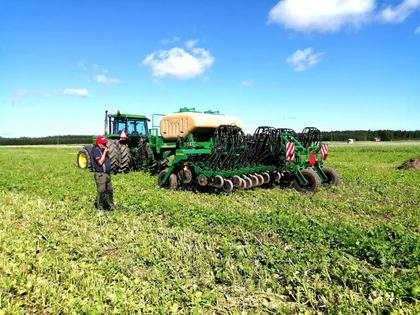
Direct Seeding and Renovation Plants as Carbon Sequestration Method at a Pilot Demo Farm in Finland

Finland
Nordic Climate
Benefits of the practice
- Direct sowing
- Cover crops
- Renovation plant
Production system(s)
Thematic Area(s)
A special plant farm in Western Finland faces a climate challenge in maintaining soil health in changing and extreme weather conditions. For two decades, Rouhiainen Farm has practiced direct seeding with several crops – including sugar beet cultivation. Efforts have also been made to increase soil organic matter by using available organic fertilizers, such as livestock manure and recycled fertilizers. Recently, various intermediate and understory crops, such as catch and renovation crops, have been introduced on the farm, improving soil structure and biological activity.
The farmer has observed the benefits of direct seeding for soil structure and water management. It reduces organic matter decomposition, enhancing the soil’s physical, chemical, and biological condition. A key indicator is the increased number of earthworms in the farmer’s fields, which have not been disturbed by tilling.
The demo event at the farm showcased the effects of direct seeding and renovation crops on soil fertility and carbon sequestration. Participants observed a no-till demonstration in the farm’s tilling radish vegetation and studied soil fertility and biological activity by digging holes and counting earthworms. Each shovel puncture revealed more than 10 earthworms, with a record of over 20.
At the Rouhiainen farm, deep- and strong-rooted renovation plants have been able to manage and prevent compaction of arable land and add organic matter to the soil, which improves soil structure, water management, biological activity and nutrient economy. In addition, catching crops can have effects on controlling plant diseases and pests.
Especially for sugar beet, renovation crops are a good solution for maintaining the structure of the field and increasing the amount of organic matter. In the future, the farm plans to experiment with researchers with other spin-off crops and methods in sugar beet cultivation.
Länsi-Suomalaisella erikoiskasvitilla koetaan haasteeksi maan kasvukunnon ylläpitäminen muuttuvissa sääoloissa. Rouhiaisen tila on jo kahden vuosikymmenen ajan harjoittanut suorakylvöä useilla viljelykasveilla – myös sokerijuurikkaan viljelyssä. Maan orgaanista ainesta on pyritty lisäämään myös käyttämällä saatavilla olevia orgaanisia lannoitteita, kuten karjanlantaa ja kierrätyslannoitteita. Viimeisimpänä tilalla on otettu käyttöön erilaisia väli- ja aluskasveja, kuten kerääjä- ja saneerauskasveja, joilla paitsi lisätään vihreitä viikkoja, parannetaan maan rakennetta ja biologista aktiivisuutta.
Viljelijä on havainnut suorakylvön suotuisat vaikutukset maan rakenteeseen ja vesitalouteen. Suorakylvö vähentää maan orgaanisen aineksen hajoamista ja siten parantaa maan fysikaalista, kemiallista ja biologista kasvukuntoa. Hyvänä osoituksena tästä on lisääntynyt lierojen määrä viljelijän pelloilla, joita ei ole häiritty muokkauksilla.
Tilalla järjestetyssä demotapahtumassa esiteltiin osallistujille suorakylvön ja saneerauskasvien vaikutusta maan kasvukunnon parantamiseen ja hiilen sidontaan. Osallistujat pääsivät seuraamaan suorakylvönäytöstä tilan muokkausretikkakasvustossa sekä tutkimaan maan kasvukuntoa ja biologista aktiivisuutta kaivamalla kuoppia ja laskemalla lierojen määrää. Jokaisesta lapionpistosta löytyi yli 10 lieroa ja ennätys oli yli 20 lieroa.
Rouhiasien tilalla syvä- ja vahvajuurisilla saneerauskasveilla on pystytty hoitamaan ja ehkäisemään peltomaan tiivistymiä ja lisäämään maahan orgaanista ainesta, mikä parantaa maan rakennetta ja vesitaloutta, biologista aktiivisuutta ja ravinnetaloutta. Lisäksi kerääjäkasveilla voi olla kasvitauteja ja -tuholaisia torjuvia vaikutuksia.
Erityisesti sokerijuurikkalla saneerauskasvit ovat hyvä ratkaisu pellon rakenteen hoitoon ja orgaanisen aineksen määrän lisäämiseen. Jatkossa tila aikoo yhteistyössä tutkijoiden kanssa kokeilla myös muita oheiskasveja ja menetelmiä sokerijuurikkaan viljelyssä.
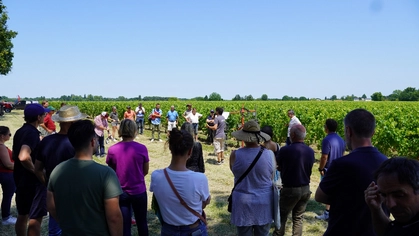
Helping Future French “Bordeaux” Winegrowers to Invent the Agriculture of Tomorrow

France
Atlantic area
Benefits of the practice
- Education
- Multi-actor capacity building
- Adaptation to climate change
Production system(s)
Thematic Area(s)
Château Dillon, 40 ha in « AOC Haut Médoc – Crus Bourgeois Supérieur », is located North of Bordeaux and is one of the three Agro Campus Bordeaux Gironde wine farms. It is also one of the ‘Pilot Demo Farms’ in the Climate Farm Demo project.
They strongly believe that knowledge exchange, capacity building and training should increasingly be based on peer-to-peer sharing and designed based on ‘working together’. The school’s motto — “collective intelligence, knowledge transfer and sharing” — guides students along a radically new path. They are working hard to maintain access to operational knowledge for those working in the field. And they rely on the strength of the collective and multi-stakeholder approach. They are strongly committed to transferring knowledge through numerous events in the field — very much aligned with Climate Farm Demo main objective!
Château Dillon is also involved in developing innovative teaching tools, such as simulators (for pruning, plot management, sprayer adjustment, etc.), ensuring that training is not dependent on the plant cycle and the seasons. Another of their major missions is to serve as a showcase site and a site for experimentation and innovation in the sector.
Therefore, in 2024, they created a 5-hectare experimental vineyard for assessing innovative practices that are both compatible with society’s expectations and economically viable. The primary aim is to create a reservoir of genetic diversity. This vineyard houses vine conservatories designed to safeguard the genetic diversity of grape varieties in the Nouvelle-Aquitaine region. The second objective is to test breakthrough scenarios. There is a long list of innovative techniques, including pruning, planting density, shading, soil conservation, robotisation, etc. And in the future, other parameters will be tested, such as energy and technical sobriety, diversification of production, agroforestry, reduction in the use of phytosanitary products, etc.
Château Dillon, 40 ha en AOC Haut Médoc – Crus Bourgeois Supérieur, situé au nord de Bordeaux, est l’une des 3 fermes viticoles de l’Agro Campus Bordeaux Gironde. C’est également l’une des fermes pilotes du projet Climate Farm Demo.
Le lycée agricole est convaincu que la montée en compétences et la formation doivent de plus en plus être basés sur les échanges entre pairs et être conçus sur la base d’un « travail en commun ». Sa devise est : « intelligence collective, transfert et partage des connaissances », afin de guider les étudiants sur une voie radicalement nouvelle. Il s’efforce de maintenir l’accès aux connaissances opérationnelles pour les acteurs de terrain et s’appuie sur la force de l’approche collective et multipartite. Il est également fortement engagé dans le transfert de connaissances par le biais de nombreux événements sur le terrain. Cela correspond tout à fait à l’objectif principal de Climate Farm Demo !
Il participe également au développement d’outils pédagogiques innovants, tels que des simulateurs (pour la taille, la gestion des parcelles, le réglage des pulvérisateurs, etc.), afin que la formation ne soit pas dépendante du cycle de la plante et des saisons. Une autre de leurs grandes missions est d’être un site vitrine et un site d’expérimentation et d’innovation pour la filière. Ainsi, en 2024, ils ont créé un vignoble expérimental de 5 hectares pour évaluer des pratiques innovantes, compatibles avec les attentes de la société et économiquement viables. L’objectif premier est de créer une banque de biodiversité génétique des cépages. Le deuxième objectif est de tester des scénarios de rupture. La liste des techniques innovantes est longue : taille, densité de plantation, ombrage, conservation des sols, robotisation, etc. Et à l’avenir, d’autres paramètres seront testés, comme la sobriété énergétique et technique, la diversification des productions, l’agroforesterie, la réduction de l’utilisation des produits phytosanitaires, etc.
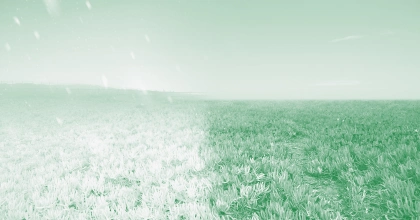
Help the Organizers of Climate Farm Demo Demonstrations (or Other Livestock Open Days) to Close Their Demonstrations by Offering a Discussion and Conclusion Exercise with the Visitors/Breeders Present at the Demonstration

Europe
All zones
Benefits of the practice
- Help with summarizing the day
- Improvements for future demonstrations
- Time saving by using a facilitating tool
As part of the Climate Farm Demo project, we are opening the farms of our breeders involved in the project. We have carried out several demonstrations to date. At the end of the first open days, we realized how interesting it is to conclude the demonstration with a final exchange with the participants.
This “closing” exchange has 2 objectives:
⦁ Collect feedback from visitors present at the demo (what you liked about the demonstration, on the organization of the day, what could be improved, etc.) with the aim of improving the next demonstrations.
⦁ Give feedback to the farmers who received us by proposing to the participants present to send them a positive point, a piece of advice.
The benefit is it helps to end the demonstration with an exchange between the participants.
To create this concluding exchange we suggest using the flower-shaped drawing below. A facilitator questions the participants and notes their feedback on the flower, either directly with a pencil on it or using post-its and positions them on the diagram.
This ‘flower’ tool, which we have adapted from the FARM DEMO toolkit, is proving to be a very interesting and powerful ally for DEMOs. It enhances the value of the farmer’s work and gets the participants involved. It strengthens exchanges and creates links.
Dans le cadre du projet Climate Farm Demo, nous sommes amenés à ouvrir les fermes de nos éleveurs engagés dans le projet. Nous avons réalisé plusieurs démonstrations à ce jour. A l’issue des premières portes ouvertes, nous nous sommes rendu compte de l’intérêt de conclure la démonstration sur un dernier échange avec les participants.
Cet échange de « clôture » a 2 objectifs
⦁ Recueillir les retours des visiteurs présents à la démo (ce qui vous a plu sur l’exploitation, dans l’organisation de la journée, ce qui serait à améliorer…) dans l’objectif de s’améliorer encore dans les prochaines démonstrations à venir
⦁ Faire un retour aux agriculteurs qui nous ont reçus en proposant aux participants présents de leur renvoyer un point positif, un conseil.
Il permet ainsi de clôturer la démonstration sur une note d’échanges entre les participants.
Pour créer cet échange de conclusion nous proposons d’utiliser le dessin en forme de fleur ci-dessous. Un animateur interroge les participants et note sur la fleur leurs retours, soit directement au crayon dessus, soit à l’aide de post-its à positionner ensuite sur le schéma.
Cet outil “fleur”, que nous avons repris et adapté du “tool-kit” de FARM DEMO, se révèle un allier très intéressant et puissant pour les DEMOs. Il permet de valoriser le travail de l’éleveur / agriculteur et d’impliquer les participants. Il renforce les échanges et crée du lien.

Water Management Dialogue Matrix: A Good Conversation About Climate Smart Solutions

Europe
All Zones
Benefits of the practice
- Climate smart water measures
- Dialogue
- Engaging farmer
Production system(s)
Thematic Area(s)
Droughts and heavy rainfall are threatening agricultural production across Europe. How can experts, farmers and advisors have constructive conversations about climate smart water management? And how can you facilitate these conversations in an interactive way? In the Netherlands, we have good experience with the water management dialogue matrix; a tool to talk about water management measures and discuss implications for farmers.
Objective: to inform farm visitors and start a conversation about climate smart water measures. For example, in the Netherlands we talked about above-ground water storage.
Dialogue matrix:
The dialogue matrix tool consists of 6 easy to follow steps. The first and second steps require some preparation by an expert (e.g. a researcher, farmer with lots of experience, and an advisor).
⦁ Prepare a list of maximum 10 climate smart water measures, appropriate to your local context. Think about e.g. above or below ground water storage, crop rotations or soil measures.
⦁ Define each measure in one or two sentences
⦁ Prepare the table below and print on A4 paper
⦁ Hand out the table to each demo visitor
⦁ Let them individually score each measure on effectiveness and feasibility (1= low, 5= high)
⦁ Plenaries discuss the answers of the audience and place each measure within the matrix below: how effective is each measure? And how feasible is it to implement?
Target audience: The water management dialogue matrix can be used in sessions with farmers, local stakeholders, and advisors.
Droogtes en hevige regenval bedreigen de landbouwproductie in heel Europa. Hoe kunnen experts, boeren en adviseurs constructieve gesprekken voeren over klimaatslim waterbeheer? En hoe kun je deze gesprekken op een interactieve manier faciliteren? In Nederland hebben we goede ervaringen met de dialoogmatrix rond watermanagement; een hulpmiddel om te praten over watermanagementmaatregelen en met boeren de implicaties van zulke maatregelen te bespreken.
Doel: bezoekers van demo bijeenkomsten informeren en een gesprek starten over klimaat slimme watermaatregelen. In de regio Veenkoloniën hebben we het bijvoorbeeld gehad over bovengrondse wateropslag.
Dialoogmatrix:
De dialoogmatrix tool bestaat uit 6 eenvoudig te volgen stappen. De eerste en tweede stap vereist enige voorbereiding door een expert (bijv. een onderzoeker, boer met veel ervaring, adviseur).
⦁ Maak een lijst van maximaal 10 klimaat slimme maatregelen, passend bij je lokale context. Denk bijvoorbeeld aan boven- of ondergrondse wateropslag, vruchtwisseling of bodemmaatregelen
⦁ Definieer elke maatregel in één of twee zinnen
⦁ Maak de onderstaande tabel en print deze uit op A4-papier;
⦁ Deel de tabel uit aan elke demobezoeker
⦁ Laat ze individueel elke maatregel scoren op effectiviteit en haalbaarheid (1= laag, 5= hoog) – check Table 1 for more detail
⦁ Bespreek plenair de antwoorden en plaats elke maatregel in de onderstaande matrix: hoe effectief is elke maatregel? En hoe haalbaar is het om te implementeren? – check Figure 1 for more details
Doelgroep: De dialoogmatrix kan worden gebruikt in gesprek met boeren en adviseurs.
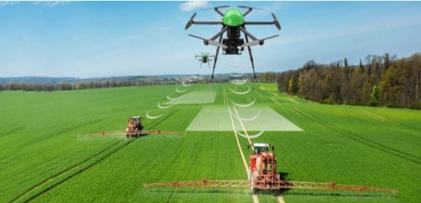
Knowledge Transfer and Exchange & Sustainable Agricultural Innovation

Hungary
Continental Climate
Benefits of the practice
- Practical knowledge transfer
- Sustainable and climate-smart farming solutions
- Collaboration between academia, advisors, and farmers
Production system(s)
Thematic Area(s)
The Albert Kázmér Faculty of Széchenyi István University operates a network of approximately 70 demonstration farms, model farms, and recognized training sites, providing a comprehensive practical demonstration and knowledge transfer infrastructure.
The network consists of diverse and innovative farms and enterprises, ranging from small, specialized farms to large multi-sector agribusinesses. Members are engaged in various agricultural sectors, including livestock farming, mixed farming, arable crop production, horticulture, the food industry, and agricultural finance. 12% of the network farms operate under organic farming principles.
The Faculty actively collaborates with network members, engaging in joint projects and research with partners committed to innovation, sustainability, and digitalization.
Many demonstration farms apply a holistic, circular farming approach, ensuring efficient resource use and long-term sustainability.
The demonstration farms serve as living laboratories, allowing for the real-world testing and implementation of climate adaptation solutions, precision farming techniques, and sustainable soil management practices. Participants gain not only theoretical knowledge but also hands-on experience with cutting-edge agricultural technologies, equipping them with practical skills for sustainable and modern farming.
A Széchenyi István Egyetem Albert Kázmér Karának mintegy 70 mintagazdasága/mintaüzeme/elismert gyakorló helye átfogó gyakorlati demonstrációs és tudásátadási infrastruktúrát biztosít.
A hálózat sokszínű és innovatív gazdaságokat és vállalkozásokat foglal magában, a kis, specializált gazdaságoktól a nagyméretű, több ágazatot lefedő agrárvállalkozásokig. A tagok tevékenysége többek között kiterjed az állattenyésztésre, a vegyes gazdálkodásra, a szántóföldi növénytermesztésre, a kertészetre, az élelmiszeriparra és a pénzügyi szektorra. A hálózatba tartozó gazdaságok 12%-a biogazdálkodást folytat.
A Kar aktív kapcsolatot ápol a hálózat tagjaival, és közös projekteken és kutatásokon keresztül dolgozik együtt azokkal a partnerekkel, akik elkötelezettek az innováció, a fenntarthatóság és a digitalizáció iránt.
Számos mintagazdaság holisztikus, körforgásos gazdálkodási megközelítést alkalmaz, amely biztosítja az erőforrások hatékony felhasználását és a hosszú távú fenntarthatóságot.
A bemutató gazdaságok lehetőséget biztosítanak a klímaadaptációs megoldások, precíziós gazdálkodási technikák és fenntartható talajhasználati módszerek valós környezetben történő kipróbálására és megismerésére. A résztvevők nemcsak elméleti tudást kapnak, hanem lehetőségük nyílik a legmodernebb technológiák gyakorlati alkalmazására is.
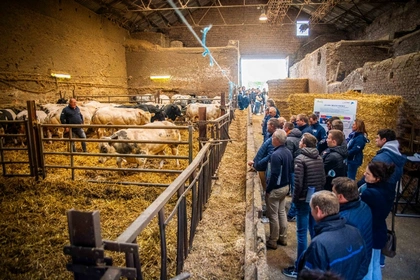
Beef Days - Success for the Digital Transition in Walloon Livestock Farming

Belgium
Temperate Maritime Climate
Benefits of the practice
- Monitoring
- Herd management
- Forage production
Production system(s)
Thematic Area(s)
During the Beef Days 2024, Elevéo, Inovéo, and Digital Wallonia delved into optimizing cattle farm management for a sustainable future. Nearly 260 livestock enthusiasts participated in the event.
The farm visit focused on presenting the services offered to beef farmers and showcasing the Van Eyck family farm. This farm raises about 500 cattle and cultivates potatoes, cereals, maize, beets, and vegetables (beans, spinach, and broad beans). Additionally, it has an innovative irrigation network. A significant portion of the forage is produced on-site: grass, beet pulp, cereals, etc.
The meat is mainly marketed through short supply chains via a farmer cooperative. The owners themselves select which animals are destined for each point of sale, and both bulls and cows are fattened on the farm.
To advance their farming practices, the owners use software and applications that facilitate decision-making.
During the Beef Days, six workshops were organized, related to practices or methods applied on this farm:
⦁ Workshop on Technical-Economic Performance and Accounting: Various indicators allow farmers to closely monitor cattle performance and make the best decisions.
⦁ Growth Monitoring Workshop: With farm scales or Elevéo’s weighing service, it is possible to closely monitor cattle weights during their growth.
⦁ Cattle Monitoring Tools Workshop: These tools save time and increase efficiency in optimizing cow health and reproductive cycles.
⦁ Forage Measurement Tools Workshop: Numerous tools exist to estimate forage quantity.
⦁ Genetics & Genomics Workshop: Genomics revolutionizes animal selection by better anticipating genetic criteria.
⦁ Mating Advice Workshop: A tool available on My Awé Net provides personalized mating advice for each herd, including inbreeding calculations.
These services aim to help farmers improve both the profitability and sustainability of their operations.
Lors des Beef Days 2024, Elevéo, Inovéo et Digital Wallonia ont exploré en profondeur l’optimisation de la gestion des élevages bovins pour un avenir durable. Près de 260 passionnés d’élevage ont participé à l’événement.
La visite de la ferme s’est concentrée sur la présentation des services offerts aux éleveurs de bovins et sur la ferme de la famille Van Eyck. Cette ferme élève environ 500 bovins et cultive des pommes de terre, des céréales, du maïs, des betteraves ainsi que des légumes (haricots, épinards et fèves des marais). De plus, elle dispose d’un réseau d’irrigation innovant. Une grande partie de l’alimentation du bétail est produite sur place : herbe, pulpe de betterave, céréales, etc.
La viande est principalement commercialisée en circuit court via une coopérative d’éleveurs. Les propriétaires choisissent eux-mêmes les animaux destinés à chaque point de vente, et les taureaux comme les vaches sont engraissés sur la ferme.
Pour améliorer leur élevage, les propriétaires utilisent des logiciels et des applications facilitant la prise de décisions.
Pendant les Beef Days, six ateliers ont été organisés, mettant en avant des pratiques ou méthodes appliquées dans cette ferme :
⦁ Atelier performances technico-économiques et comptabilité : Les différents indicateurs permettent aux éleveurs de suivre de près la performance des bovins et de prendre les meilleures décisions.
⦁ Atelier suivi de croissance : Avec des balances à la ferme ou le service de pesée d’Élevéo, il est possible de suivre de près les poids des bovins au cours de leur croissance.
⦁ Atelier outils de monitoring des bovins : Ces outils offrent un gain de temps et d’efficacité pour optimiser la santé et le cycle de reproduction des vaches.
⦁ Atelier outils de mesure des fourrages : De nombreux outils existent pour estimer la quantité de fourrage.
⦁ Atelier Génétique & Génomique : La génomique révolutionne la sélection animale en permettant de mieux anticiper les critères génétiques.
⦁ Atelier conseil d’accouplement : Un outil disponible sur My Awé Net fournit des conseils personnalisés sur les accouplements dans chaque troupeau, avec des calculs de consanguinité.
Ces services visent à accompagner les éleveurs pour améliorer à la fois la rentabilité et la durabilité de leur exploitation.
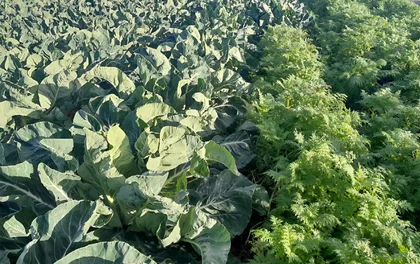
Improving Soil Organic Content on Vegetable Farms in Brittany: Material, Technical and Cultural levers

France
Atlantic Zone
Benefits of the practice
- Increased water retention
- Carbon storage
- Improved soil structure and fertility
Production system(s)
Thematic Area(s)
An organic open-field vegetable farm in Nord Finistère (France, Brittany region) is addressing the challenges of climate change by implementing innovative solutions to improve soil health and enhance resilience.
1. Setting up a composting platform (under consideration)
In response to the increasing scarcity of manure, the farm aims to compost its own organic waste (particularly 55 tonnes of leek waste) instead of sending it to a nearby biogas plant. This solution would:
⦁ Increase self-sufficiency in organic matter, which is essential for soil fertility and water retention.
⦁ Reduce tractor trips, thereby lowering the environmental impact.
⦁ Produce a carbon-rich soil improver that enhances soil structure and biological activity.
2. Optimizing plant cover
The farmer systematically plants cover crops after harvests to enrich the soil. He is participating in an economic and environmental interest group to refine species selection and mixtures suited to vegetable rotations. An innovative seeding system has been developed to:
⦁ Sow cover crops in the uncultivated alleys of cauliflower fields, increasing carbon storage and soil structure.
⦁ Maximize biomass production to improve water retention and fertility.
To reduce soil compaction, the farmer has equipped a tractor with a remote tyre inflation system. Air pressure is reduced when working in the fields (harvesting winter vegetables, tilling the soil, and sowing cover crops). Mini-profiles have been created to observe the effect of this equipment during leek harvests in the winter of 2023–2024.
These practices enhance the farm’s resilience by limiting erosion, increasing carbon storage, and improving the soil’s ability to withstand drought and excess water.
Une exploitation bio de légumes plein champ en Nord Finistère fait face aux défis du changement climatique en mettant en place des solutions innovantes pour améliorer la santé de ses sols et renforcer leur résilience.
1. Mise en place d’une plateforme de compostage (en réflexion)
Face à la raréfaction du fumier, l’exploitation souhaiterait composter ses propres déchets organiques (notamment 55 tonnes de déchets de poireaux) au lieu de les envoyer à un méthaniseur voisin. Cette solution permettrait :
⦁ D’être plus autonome en matière organique, essentielle pour la fertilité et la rétention en eau des sols.
⦁ De limiter les trajets et donc l’impact environnemental.
⦁ De produire un amendement riche en carbone, améliorant la structure et la vie biologique du sol.
2. Optimisation des couverts végétaux
L’exploitant utilise systématiquement des couverts végétaux après les cultures pour enrichir ses sols. Il participe à un GIEE (Groupe d’Intêret Economique et Environnemental) pour affiner ses choix d’espèces et de mélanges adaptés aux rotations légumières. Un semis innovant a été développé :
⦁ Semer des couverts dans les allées non cultivées des champs de chou-fleur, afin de stocker davantage de carbone et d’améliorer la structure du sol.
⦁ Maximiser la biomasse produite pour une meilleure rétention en eau et une fertilité accrue.
Afin de réduire le tassement des sols, l’exploitant a également équipé un tracteur d’un système de télégonflage des pneumatiques. La pression d’air est réduite lors des travaux des champs (récoltes de légumes d’hiver, travail du sol, semis de couverts). La réalisation de mini-profils a permis d’observer l’effet de ce matériel lors des récoltes de poireaux pendant l’hiver 2023-2024.
Ces pratiques renforcent la résilience de l’exploitation en limitant l’érosion, en augmentant le stockage du carbone et en améliorant la capacité des sols à faire face aux sécheresses et aux excès d’eau.

Farming With Trees – Opportunities Through Agroforestry

UK
All Zones
Benefits of the practice
- Carbon Sequestration & Soil Health: Trees enhance carbon storage above and below ground, improve soil organic matter, structure, drainage, and nutrient cycling.
- Protection & Erosion Control: Trees provide shelter against extreme weather, safeguard livestock and crops, limit wind and water erosion, and offer shade.
- Diversification & Resilience: Agroforestry increases farm income by utilizing marginal land, enhances climate resilience, and reduces input needs for feed, water, and pest control.
Production system(s)
Thematic Area(s)
Integrating trees into UK farmland is not new; some argue the landscape is naturally a mix of farmland and trees. However, post-WWII until the mid-80s, farmers were incentivized to remove hedges and enlarge fields for machinery, later risking payment losses if planting trees on arable land (1). Today, tree farming benefits are recognized, with grants supporting diversification. The UK Government Agroforestry Handbook categorizes tree integration into in-field (silvoarable, silvopasture, wood pasture, orchards) and around-field (trees in hedges, trees in fields, windbreaks, riparian buffers) systems. Farmers can combine these based on farm needs and funding.
EcoFarm in Nottingham, a 26-hectare Climate Demo Farm, is managed by a Community Benefit Society. It integrates trees into two agroforestry systems: 740 trees in arable fields between 24-meter cropping alleys with wildflower strips and 3,700 trees in woodland with grazing sheep.
After 10 years, research with the University of Reading found alley planting delivers greater environmental gains than broadacre planting, also improving soil health. A key non-cash benefit is community involvement, as volunteers help with planting and harvesting (2).
Whitehall Farm in Cambridgeshire, another Climate Demo Farm, established a silvoarable orchard system in 2009, planting 4,500 apple trees across 52 hectares. Trees are spaced 3 meters apart, with an understory of clovers, vetch, and wildflowers. 27-meter cropping alleys allow machinery access. Tree row orientation reduces shading and wind erosion, a common Fens challenge. Late-ripening apples enable cereal harvests in late summer, followed by apple picking in autumn. With a 15-year tenancy, apples provided a strong return on investment, while also improving soil protection, pest control, and biodiversity (3).
Sources:
(1) UK Government Guide to Agroforestry
(2) Farmers Weekly – Agroforestry in Nottingham
(3) Agroforestry Net – Whitehall Farm
